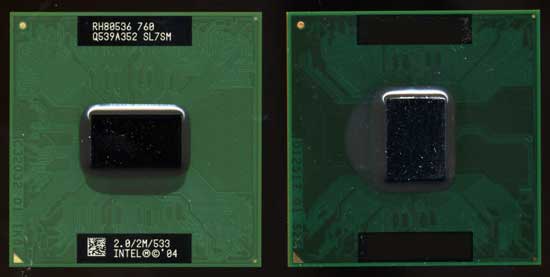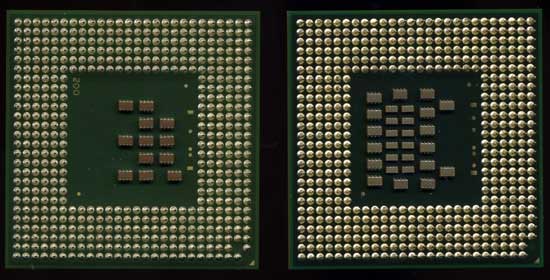Intel Core Duo (Yonah) Performance Preview - Part II
by Anand Lal Shimpi on December 19, 2005 12:55 PM EST- Posted in
- CPUs
It's called the Core Duo
When Yonah first started appearing on roadmaps, we knew it as Jonah, which then starting being written as Yonah. Eventually, Intel confirmed its existence and we had always assumed that it would continue to use the name Pentium M. However, given the great importance of the launch of Intel's first dual-core, low power, notebook processor, it shouldn't be much of a surprise that Intel has a new name in store for it. As you've probably already heard, Yonah will receive the marketing name "Core" with the words "Duo" or "Solo" following it depending on whether it is the dual or single core version. The name Centrino will still be there, but instead of referring to the processor as a Pentium M, it'll be called a Core Duo or a Core Solo. The Centrino platform itself will be referred to as Centrino Duo when paired with a Core Duo processor. We have to admit, we kind of like the new name.
Not so pleasant, however, are the new processor numbers that go along with the new processor names. Gone are Intel's simple three-digit numbers and they have since been replaced with a four-digit number preceded by a letter. The letter indicates the thermal envelope of the processor, while the following four digits denote the performance level of the CPU. If you think that this sounds oddly similar to AMD's Turion processor nomenclature, don't worry; you'd be completely right (of course, the Turion only uses two numbers, while Core Duo uses four). Maybe, one of these days, Intel will get around to copying some more important elements of AMD's history, such as an on-die memory controller or at least a serial bus interface.
As an example of the numbers in use, the 2.0GHz processor that we previewed in the first article will be sold under the name "Intel Core Duo T2500". For your reference, the T2600 will run at 2.16GHz (compared to the 2.0GHz T2500). The Core Solo processors will feature a "1" after the "T" denoting a single core; for example, the Intel Core Solo T1300 will run at 1.66GHz.
Intel's Core Duo and Solo processors both support a 667MHz FSB, which is enabled by the 945 chipset that Intel is pairing with them. The move to a 667MHz FSB is necessary, thanks to the increased bandwidth demands of a dual core processor.
As we mentioned in the first article, the Core Duo (and Solo) processors are not pin-compatible with the older Pentium M, even though they physically have the same number of pins.
When Yonah first started appearing on roadmaps, we knew it as Jonah, which then starting being written as Yonah. Eventually, Intel confirmed its existence and we had always assumed that it would continue to use the name Pentium M. However, given the great importance of the launch of Intel's first dual-core, low power, notebook processor, it shouldn't be much of a surprise that Intel has a new name in store for it. As you've probably already heard, Yonah will receive the marketing name "Core" with the words "Duo" or "Solo" following it depending on whether it is the dual or single core version. The name Centrino will still be there, but instead of referring to the processor as a Pentium M, it'll be called a Core Duo or a Core Solo. The Centrino platform itself will be referred to as Centrino Duo when paired with a Core Duo processor. We have to admit, we kind of like the new name.
Not so pleasant, however, are the new processor numbers that go along with the new processor names. Gone are Intel's simple three-digit numbers and they have since been replaced with a four-digit number preceded by a letter. The letter indicates the thermal envelope of the processor, while the following four digits denote the performance level of the CPU. If you think that this sounds oddly similar to AMD's Turion processor nomenclature, don't worry; you'd be completely right (of course, the Turion only uses two numbers, while Core Duo uses four). Maybe, one of these days, Intel will get around to copying some more important elements of AMD's history, such as an on-die memory controller or at least a serial bus interface.
As an example of the numbers in use, the 2.0GHz processor that we previewed in the first article will be sold under the name "Intel Core Duo T2500". For your reference, the T2600 will run at 2.16GHz (compared to the 2.0GHz T2500). The Core Solo processors will feature a "1" after the "T" denoting a single core; for example, the Intel Core Solo T1300 will run at 1.66GHz.
Intel's Core Duo and Solo processors both support a 667MHz FSB, which is enabled by the 945 chipset that Intel is pairing with them. The move to a 667MHz FSB is necessary, thanks to the increased bandwidth demands of a dual core processor.
As we mentioned in the first article, the Core Duo (and Solo) processors are not pin-compatible with the older Pentium M, even though they physically have the same number of pins.

Dothan (Pentium M) on the left, Yonah (Core Duo) on the Right

Dothan (Pentium M) on the left, Yonah (Core Duo) on the Right










103 Comments
View All Comments
Shintai - Monday, December 19, 2005 - link
I doubt a a laptop uses 108W and got a x800XT. That powerchart is close to useless.A Core Duo laptop is 31 peak for CPU and 2.5 for the 945GM. A single core tution is 35W. unless you want 25W part, but then we gotta use the lower intel part aswell.
Dualcore Turion wont even stand a chance until it get 65nm.
Furen - Tuesday, December 20, 2005 - link
The 25W Turion parts are $5 more expensive than the 35W parts, hardly comparable with the price difference between regular and LV Intel CPUs. I agree with you in that I dont expect 90nm Turions to match Yonah's power consumption but I must say that what I've heard about the Yamato platform (which, to tell the truth, is almost nothing) makes me think that it'll be a closer match than we think.Missing Ghost - Monday, December 19, 2005 - link
What, no 64 bit?I won't buy this.
fitten - Tuesday, December 20, 2005 - link
Do you actually use 64-bit or is it just a feature checkbox? I bought some Athlon64s because they were 64-bit and allowed me to test the software I write on a 64-bit platform, for example... not that the codes I actually write require many of the features of 64-bit, though. In the past, I have written and worked on a number of projects that actually need 64-bit (typically just very large datasets which can just be used flat in 64-bit as opposed to all sorts of tiling and paging on a 32-bit machine).Chickan - Monday, December 19, 2005 - link
Did anyone else notice that the numbers in the graph for Black and White did not match up with the spreadsheet below it? According to the graph, the Core Duo hit 44.5 FPS, the same as the X2 2ghz w/ 1mbx2, but in the sheet below, it is reported to only do 40.1 FPS, lower than even the Pentium M. In fact, it performs the worst out of all the CPU's there, at every resolution, even though this is not reported, nor mentioned.I also find it interesting that Intel's new line is only able to match X2's, not beat them. Either way, lets see some new stuff from AMD!
KazenoKoe - Monday, December 19, 2005 - link
Odd, the article clearly has it at 42.3fps on both the graph and the table. The Pentium M got 40.1 and the X2 2GHz/1MB got 44.5.WitchKing - Monday, December 19, 2005 - link
I enjoyed reading this 2nd article on the next Intel platform.Although I am basically in favor of AMD since Athlon platform, I am quite glad that Intel is closing the performance gap. It will make AMD move further ;-)
Anyway, it should be quite interesting to see how these 2 platforms compare in 64-bits tasks (Windows XP-64, Vista (is a 64-bits version available yet?) and linux based).
A 3rd opus of this article maybe? ;-)
saratoga - Monday, December 19, 2005 - link
Yonah does not support x86-64, so doing 64 bit testing is not possible.phaxmohdem - Monday, December 19, 2005 - link
I thought this review was much better than the first. Thanks guys. It pretty much illustrates the same thing, but it is interesting to read about new CPU's none the less.I don't mind the name personally, I think that we uber-nerds don't like it because we actually know what a core is in regards to a CPU. Your typical idiot customer doesn't know what a Core, or Processor die is, and Core is just another brand name like Pentium.
While these chips look freaking awesome for laptop use, I must admit I will ver very dissapointed it Conroe launches, and only brings Intel back to equality with AMD. When a new generation of CPU launches, I generally like to think that they are releaseing something to regain their status as performance leader, not just level the playing field. (Though I guess PII/PIII/P4 al launched with worse performance than the high end of their predecessors)
tfranzese - Monday, December 19, 2005 - link
If memory serves, the only one to launch with a loss in performance was the Pentium 4. The Pentium II was a great advancement over the Pentium it replaced (not the Pro) and the Pentium III performed equally, though was available at higher clock speeds. That said, I don't know where you got to grouping the PII and PIII in with the P4's poor launch status. Willamette was a joke.